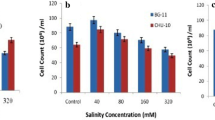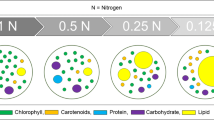Abstract
Microalgae have emerged as one of the most promising alternative sources of biofuels due to their high lipid accumulation ability. High lipid content is of pivotal importance for biodiesel production. In order to obtain high lipid content, modifications of culture conditions and development of an efficient lipid induction method are called for. In the present study, the possibility of using selenium in a form of sodium selenite as a lipid inductor in marine microalga Dunaliella tertiolecta was investigated during one- and two-stage cultivation modes. The effects of selenite on algal growth, pigment content, oxidative stress, and neutral lipid content were determined during both cultivation modes. The results revealed that the two-stage cultivation on 10.00–40.00 mg L−1 of selenite resulted in up to twofold higher algal cell density compared to the one-stage cultivation. Selenite concentrations from 2.50 to 20.00 mg L−1 increased lipid peroxidation during both cultivation modes, emphasizing the selenite-induced oxidative stress accompanied by the increased lipid accumulation in microalgae cells. During one- and two-stage cultivation on 20.00 mg L−1 of selenite, lipid content increased 2.39- and 5.73-fold at days 9 and 14 of cultivation, respectively. Moreover, the highest obtained neutral lipid content during the two-stage cultivation was 5.40-fold higher than lipid content obtained during the one-stage cultivation. Collectively, these results suggest that the two-stage cultivation strategy, initiated with optimal culture conditions for biomass production and followed by the addition of selenite as a stress inductor, can be successfully deployed to enhance the lipid content in D. tertiolecta.





Similar content being viewed by others
Data Availability
The data underlying this article are available in the article. Raw data files will be shared on reasonable request to the corresponding author.
References
Hu, Q., Sommerfeld, M., Jarvis, E., Ghirardi, M., Posewitz, M., Seibert, M., & Darzins, A. (2008). Microalgal triacylglycerols as feedstocks for biofuel production: Perspectives and advances. Plant Journal. https://doi.org/10.1111/j.1365-313X.2008.03492.x
Zhu, L. D., Li, Z. H., & Hiltunen, E. (2016). Strategies for lipid production improvement in microalgae as a biodiesel feedstock. BioMed Research International. https://doi.org/10.1155/2016/8792548
Xia, L., Ge, H., Zhou, X., Zhang, D., & Hu, C. (2013). Photoautotrophic outdoor two-stage cultivation for oleaginous microalgae Scenedesmus obtusus XJ-15. Bioresource Technology. https://doi.org/10.1016/j.biortech.2013.06.112
Doan, Y. T. T., & Obbard, J. P. (2015). Two-stage cultivation of a Nannochloropsis mutant for biodiesel feedstock. Journal of Applied Phycology. https://doi.org/10.1007/s10811-014-0490-4
Su, C. H., Chien, L. J., Gomes, J., Lin, Y. S., Yu, Y. K., Liou, J. S., & Syu, R. J. (2011). Factors affecting lipid accumulation by Nannochloropsis oculata in a two-stage cultivation process. Journal of Applied Phycology. https://doi.org/10.1007/s10811-010-9609-4
Yang, J. S., Cao, J., Xing, G. L., & Yuan, H. L. (2015). Lipid production combined with biosorption and bioaccumulation of cadmium, copper, manganese and zinc by oleaginous microalgae Chlorella minutissima UTEX2341. Bioresource Technology. https://doi.org/10.1016/j.biortech.2014.10.124
Sun, X., Cao, Y., Xu, H., Liu, Y., Sun, J., Qiao, D., & Cao, Y. (2014). Effect of nitrogen-starvation, light intensity and iron on triacylglyceride/carbohydrate production and fatty acid profile of Neochloris oleoabundans HK-129 by a two-stage process. Bioresource Technology, 155. https://doi.org/10.1016/j.biortech.2013.12.109
Pancha, I., Chokshi, K., Maurya, R., Trivedi, K., Patidar, S. K., Ghosh, A., & Mishra, S. (2015). Salinity induced oxidative stress enhanced biofuel production potential of microalgae Scenedesmus sp. CCNM 1077. Bioresource Technology. https://doi.org/10.1016/j.biortech.2015.04.017
Ho, S. H., Chen, C. Y., & Chang, J. S. (2012). Effect of light intensity and nitrogen starvation on CO 2 fixation and lipid/carbohydrate production of an indigenous microalga Scenedesmus obliquus CNW-N. Bioresource Technology, 113. https://doi.org/10.1016/j.biortech.2011.11.133
Converti, A., Casazza, A. A., Ortiz, E. Y., Perego, P., & Del Borghi, M. (2009). Effect of temperature and nitrogen concentration on the growth and lipid content of Nannochloropsis oculata and Chlorella vulgaris for biodiesel production. Chemical Engineering and Processing: Process Intensification. https://doi.org/10.1016/j.cep.2009.03.006
Ota, M., Kato, Y., Watanabe, M., Sato, Y., Smith, R. L., Rosello-Sastre, R., … Inomata, H. (2011). Effects of nitrate and oxygen on photoautotrophic lipid production from Chlorococcum littorale. Bioresource Technology. https://doi.org/10.1016/j.biortech.2010.10.024
Kaewkannetra, P., Enmak, P., & Chiu, T. (2012). The effect of CO2 and salinity on the cultivation of scenedesmus obliquus for biodiesel production. Biotechnology and Bioprocess Engineering. https://doi.org/10.1007/s12257-011-0533-5
Ren, H. Y., Liu, B. F., Ma, C., Zhao, L., & Ren, N. Q. (2013). A new lipid-rich microalga Scenedesmus sp. strain R-16 isolated using Nile red staining: Effects of carbon and nitrogen sources and initial pH on the biomass and lipid production. Biotechnology for Biofuels. https://doi.org/10.1186/1754-6834-6-143
Pandit, P. R., Fulekar, M. H., & Karuna, M. S. L. (2017). Effect of salinity stress on growth, lipid productivity, fatty acid composition, and biodiesel properties in Acutodesmus obliquus and Chlorella vulgaris. Environmental Science and Pollution Research. https://doi.org/10.1007/s11356-017-8875-y
Zhong, Y., & Cheng, J. J. (2017). Effects of Selenite on Unicellular Green Microalga Chlorella pyrenoidosa: Bioaccumulation of selenium, enhancement of photosynthetic pigments, and amino acid production. Journal of Agricultural and Food Chemistry. https://doi.org/10.1021/acs.jafc.7b04246
Araie, H., & Shiraiwa, Y. (2009). Selenium utilization strategy by microalgae. Molecules. https://doi.org/10.3390/molecules14124880
Tang, H., Abunasser, N., Garcia, M. E. D., Chen, M., Simon Ng, K. Y., & Salley, S. O. (2011). Potential of microalgae oil from Dunaliella tertiolecta as a feedstock for biodiesel. Applied Energy. https://doi.org/10.1016/j.apenergy.2010.09.013
Mata, T. M., Martins, A. A., & Caetano, N. S. (2010). Microalgae for biodiesel production and other applications: A review. Renewable and Sustainable Energy Reviews. https://doi.org/10.1016/j.rser.2009.07.020
Song, D., Xi, B., & Sun, J. (2016). Characterization of the growth, chlorophyll content and lipid accumulation in a marine microalgae Dunaliella tertiolecta under different nitrogen to phosphorus ratios. Journal of Ocean University of China, 15(1), 124–130. https://doi.org/10.1007/s11802-016-2797-z
Ashour, M., Elshobary, M. E., El-Shenody, R., Kamil, A. W., & Abomohra, A. E. F. (2019). Evaluation of a native oleaginous marine microalga Nannochloropsis oceanica for dual use in biodiesel production and aquaculture feed. Biomass and Bioenergy. https://doi.org/10.1016/j.biombioe.2018.12.009
OECD. (2011). OECD Guidelines for the testing of chemicals. Freshwater alga and cyanobacteria, growth inhibition test. Organisation for Economic Cooperation and Development. https://doi.org/10.1787/9789264203785-en
Hagerthey, S. E., William Louda, J., & Mongkronsri, P. (2006). Evaluation of pigment extraction methods and a recommended protocol for periphyton chlorophyll a determination and chemotaxonomic assessment. Journal of Phycology. https://doi.org/10.1111/j.1529-8817.2006.00257.x
Lichtenthaler, H. K. (1987). Chlorophylls and carotenoids: Pigments of photosynthetic biomembranes. Methods in Enzymology, 148(C), 350–382. https://doi.org/10.1016/0076-6879(87)48036-1
El Arroussi, H., Benhima, R., Bennis, I., El Mernissi, N., & Wahby, I. (2015). Improvement of the potential of Dunaliella tertiolecta as a source of biodiesel by auxin treatment coupled to salt stress. Renewable Energy. https://doi.org/10.1016/j.renene.2014.12.010
Priscu, J. C., Priscu, L. R., Palmisano, A. C., & Sullivan, C. W. (1986). Estimation of neutral lipid levels in antarctic sea ice microalgae by nile red fluorescence. Antarctic Science. https://doi.org/10.1017/S0954102090000190
Yilancioglu, K., Cokol, M., Pastirmaci, I., Erman, B., & Cetiner, S. (2014). Oxidative stress is a mediator for increased lipid accumulation in a newly isolated Dunaliella salina strain. PLoS ONE. https://doi.org/10.1371/journal.pone.0091957
Babaei, A., Ranglová, K., Malapascua, J. R., & Masojídek, J. (2017). The synergistic effect of Selenium (selenite, –SeO32−) dose and irradiance intensity in Chlorella cultures. AMB Express, 7(1). https://doi.org/10.1186/s13568-017-0348-7
Zhang, Z., Zhang, J., & Xiao, J. (2014). Selenoproteins and selenium status in bone physiology and pathology. Biochimica et Biophysica Acta - General Subjects. https://doi.org/10.1016/j.bbagen.2014.08.001
Li, Y., Mu, J., Chen, D., Han, F., Xu, H., Kong, F., … Feng, B. (2013). Production of biomass and lipid by the microalgae Chlorella protothecoides with heterotrophic-Cu(II) stressed (HCuS) coupling cultivation. Bioresource Technology. https://doi.org/10.1016/j.biortech.2013.08.153
Reunova, Y. A., Aizdaicher, N. A., Khristoforova, N. K., & Reunov, A. A. (2007). Effects of selenium on growth and ultrastructure of the marine unicellular alga Dunaliella salina (Chlorophyta). Russian Journal of Marine Biology, 33(2), 125–132. https://doi.org/10.1134/S1063074007020071
Dazhi, W., Zhaodi, C., Shaojing, L., & Yahui, G. (2003). Toxicity and accumulation of selenite in four microalgae. Chinese Journal of Oceanology and Limnology. https://doi.org/10.1007/bf02842844
Sun, X. M., Ren, L. J., Bi, Z. Q., Ji, X. J., Zhao, Q. Y., Jiang, L., & Huang, H. (2018). Development of a cooperative two-factor adaptive-evolution method to enhance lipid production and prevent lipid peroxidation in Schizochytrium sp. Biotechnology for Biofuels. https://doi.org/10.1186/s13068-018-1065-4
Dou, X., Lu, X.-H., Lu, M.-Z., Yu, L.-S., Xue, R., & Ji, J.-B. (2013). The effects of trace elements on the lipid productivity and fatty acid composition of Nannochloropis oculata. Journal of Renewable Energy. https://doi.org/10.1155/2013/671545
Ra, C. H., Kang, C. H., Kim, N. K., Lee, C. G., & Kim, S. K. (2015). Cultivation of four microalgae for biomass and oil production using a two-stage culture strategy with salt stress. Renewable Energy. https://doi.org/10.1016/j.renene.2015.02.002
Li, Z. Y., Guo, S. Y., & Li, L. (2003). Bioeffects of selenite on the growth of Spirulina platensis and its biotransformation. Bioresource Technology. https://doi.org/10.1016/S0960-8524(03)00041-5
Schiavon, M., Ertani, A., Parrasia, S., & Vecchia, F. D. (2017). Selenium accumulation and metabolism in algae. Aquatic Toxicology. https://doi.org/10.1016/j.aquatox.2017.05.011
Gojkovic, Ž, Garbayo, I., Ariza, J. L. G., Márová, I., & Vílchez, C. (2015). Selenium bioaccumulation and toxicity in cultures of green microalgae. Algal Research. https://doi.org/10.1016/j.algal.2014.12.008
Minhas, A. K., Hodgson, P., Barrow, C. J., & Adholeya, A. (2016). A review on the assessment of stress conditions for simultaneous production of microalgal lipids and carotenoids. Frontiers in Microbiology. https://doi.org/10.3389/fmicb.2016.00546
Zheng, Y., Li, Z., Tao, M., Li, J., & Hu, Z. (2017). Effects of selenite on green microalga Haematococcus pluvialis: Bioaccumulation of selenium and enhancement of astaxanthin production. Aquatic Toxicology. https://doi.org/10.1016/j.aquatox.2016.12.008
Liu, W., Ming, Y., Li, P., & Huang, Z. (2012). Inhibitory effects of hypo-osmotic stress on extracellular carbonic anhydrase and photosynthetic efficiency of green alga Dunaliella salina possibly through reactive oxygen species formation. Plant Physiology and Biochemistry. https://doi.org/10.1016/j.plaphy.2012.01.018
Chen, T. F., Zheng, W. J., Wong, Y. S., & Yang, F. (2008). Selenium-induced changes in activities of antioxidant enzymes and content of photosynthetic pigments in spirulina platensis. Journal of Integrative Plant Biology. https://doi.org/10.1111/j.1744-7909.2007.00600.x
Breuer, G., Lamers, P. P., Martens, D. E., Draaisma, R. B., & Wijffels, R. H. (2013). Effect of light intensity, pH, and temperature on triacylglycerol (TAG) accumulation induced by nitrogen starvation in Scenedesmus obliquus. Bioresource Technology. https://doi.org/10.1016/j.biortech.2013.05.105
Rumin, J., Bonnefond, H., Saint-Jean, B., Rouxel, C., Sciandra, A., Bernard, O., … Bougaran, G. (2015). The use of fluorescent Nile red and BODIPY for lipid measurement in microalgae. Biotechnology for Biofuels. https://doi.org/10.1186/s13068-015-0220-4
Rizwan, M., Mujtaba, G., & Lee, K. (2017). Effects of iron sources on the growth and lipid/carbohydrate production of marine microalga Dunaliella tertiolecta. Biotechnology and Bioprocess Engineering, 22(1), 68–75. https://doi.org/10.1007/s12257-016-0628-0
Che, R., Huang, L., & Yu, X. (2015). Enhanced biomass production, lipid yield and sedimentation efficiency by iron ion. Bioresource Technology. https://doi.org/10.1016/j.biortech.2015.05.009
Han, S. F., Jin, W., Abomohra, A. E. F., Tu, R., Zhou, X., He, Z., … Xie, G. jun. (2019). Municipal wastewater enriched with trace metals for enhanced lipid production of the biodiesel-promising microalga Scenedesmus obliquus. Bioenergy Research. https://doi.org/10.1007/s12155-019-10042-5
Funding
This study was financially supported by the Scientific Centre of Excellence for Marine Bioprospecting–BioProCro, a project co-financed by the Croatian Government and the European Union through the European Regional Development Fund–the Competitiveness and Cohesion Operational Programme (KK.01.1.1.01).
Author information
Authors and Affiliations
Contributions
MGP: conceptualization, methodology, visualization, writing—original draft. SB: conceptualization, validation, writing—review and editing. LČ: conceptualization, validation, writing—review and editing. AS: conceptualization. NTP: validation, writing—review and editing. MDS: resources, funding acquisition. ISP: validation, writing—review and editing. RČR: resources, funding acquisition, writing—review and editing. All authors read and approved the final manuscript.
Corresponding author
Ethics declarations
Ethical Approval
Not applicable.
Consent to Participate
Not applicable.
Consent to Publish
Not applicable.
Competing Interests
The authors declare no competing interests.
Additional information
Publisher's Note
Springer Nature remains neutral with regard to jurisdictional claims in published maps and institutional affiliations.
Supplementary Information
Below is the link to the electronic supplementary material.
Rights and permissions
About this article
Cite this article
Perečinec, M.G., Babić, S., Čižmek, L. et al. Selenite as a Lipid Inductor in Marine Microalga Dunaliella tertiolecta: Comparison of One-Stage and Two-Stage Cultivation Strategies. Appl Biochem Biotechnol 194, 930–949 (2022). https://doi.org/10.1007/s12010-021-03659-w
Received:
Accepted:
Published:
Issue Date:
DOI: https://doi.org/10.1007/s12010-021-03659-w




